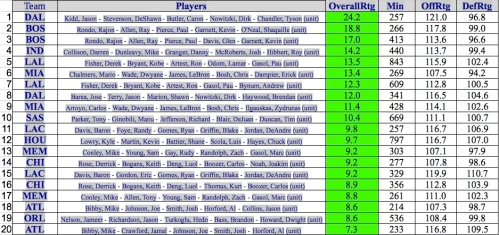When the playoffs roll around (April 16, 2011) NBA teams typically shorten their rotations and bank on core units to play heavy minutes. I thought it would be worth examining the top 5-man units in the league this year, since (in theory) they will be logging more minutes in the postseason than they have throughout the year.
From Basketball Value, here are the top 5-man units in the league this year with a minimum of 200 minutes played (OverallRtg is the net difference per 100 possessions, or Offensive Rating minus Defensive Rating):
So, in a relatively small sample (257 minutes) Dallas boasts the league’s best – err, wait a second. Caron Butler is part of that league-best unit for the Mavs, and unofficially, he is out for the season. So that lineup has no relevance going into the postseason. Which makes the best lineup the Boston Celtics starting five with Shaquille O’Neal at center…only Shaq has been out with a mysterious achilles injury since February 2.
After all the trades and injuries, that list deserves some housekeeping. The above rankings also include multiple lineups from the same team, so let’s only look at each team’s top 5-man group so we can rank teams by their best lineup.
Here is what that new list looks like, filtering for lineups (1) that still exist and (2) played a minimum of 200 minutes:
Some notable new lineups are missing after the active trading spree this year:
- Kendrick Perkins’ best lineup in OKC has logged 73 minutes with a 108 ORtg and 96 DRtg (+12 overall)
- Jeff Green’s best Boston lineup has logged 42 minutes with a 118 ORtg and 105 DRtg (+13 overall)
- Denver’s best non-Carmelo/Billups lineup (Lawson, Afflalo, Chandler, Martin, Nene) has a 102 ORtg and 96 DRtg in (+6 overall) in 98 minutes, with two more ~50 minute lineups featuring Chandler posting astronomical results (here and here.)
- The Knicks best lineup post-trade is posting a 130 ORtg and 110 DRtg (+20 overall) in 83 minutes.
- Atlanta’s best Kirk Hinrich lineup is -7 overall.
Upon seeing Indiana’s place on that list, one’s first reaction might be shock and an undesirable itch to refresh the browser and make sure it’s parsing correctly. Thanks to the wizardry of basketballvalue, we can see the teams this Pacers group has done damage against; There’s no cause for panic.
The Indiana unit has outscored opponents by 125 points, with 54% of that differential amassed in games against nine sub-.500 teams — Sacramento, Cleveland, Washington, Toronto, New Jersey, Milwaukee, Minnesota, Charlotte and Detroit — with a combined win percentage of .299. Reassuringly, it’s just Fool’s Gold.
Is This a Good Historical Predictor?
A quick cursory glance using the 20-20 vision of hindsight shows:
In 2010, the top lineups by this measure were:
- Dallas (18.8)
- Phoenix (16.6)
- Orlando (16.4)
- Portland (16.2)
- Milwaukee (14.3)
- Boston/LA Lakers (13.3)
Portland can be excused because of Brandon Roy’s injury. Dallas lost to San Antonio (9th last year), and the Suns surprised some people by pushing the Lakers to the brink for the WCF title. Boston, sporting the league’s 10th best SRS, knocked off Cleveland (12th last year). Milwaukee is a notable outlier. Then again, Utah was 3rd in SRS and had the 19th-ranked team by lineup – the Jazz were swept by LA in the second round.
In 2009, the top lineups were:
- Orlando (23.8)
- Cleveland (19.5)
- Portland (18.5)
- LA Lakers (18.1)
- Dallas (11.4)
- Boston (11.1)
Orlando made a “surprising” run to the Finals. Portland lost to Houston (8th), although Nic Batum only played 63 minutes in the series and he was part of their token lineup. Boston was missing Kevin Garnett. And the major outlier was Denver (19th), who knocked off Dallas in the second round. Again, Utah fared well in SRS (8th) but finished just 18th in 5-man unit rankings. The Jazz lost in five games to LA.
It looks like there is good predictive value — especially when compared to SRS — in looking at top 5-man units. Which means the Bulls might have to wait for a 7th championship banner. Food for thought with the playoffs on the horizon.


Adjusted +/- of the units should give even better predictive power.
Good point. I was keeping it simple here while introducing the idea…but it should.
I agree with your overarching argument- that the starters (or at least, the guy’s at the top of the roster) mean more than depth does in the playoffs.
I’m always wary of making regular season to postseason translations or using what happened in the regular season to predict what will happen in the playoffs though. Orlando in 2009 was a deeply flawed team that made their great run by running into a Boston team without their most important player (KG) and an even more flawed team (a CLE team with slow bigs and short smalls was perfect for ORL’s gimmicky 4-shooters scheme). That Magic 5-man unit this year is in my opinion geared towards more of a legitimate playoff run, despite it being a noticeably lesser five-man unit to the 2009 version relative to the competition. I think this mainly because of Bass vs. Lewis (admittedly hard to adjust for Dwight’s improvement though).
I think that Thunder lineup with Perkins is going to get better and better. Team is so scary right now.
Great work man.